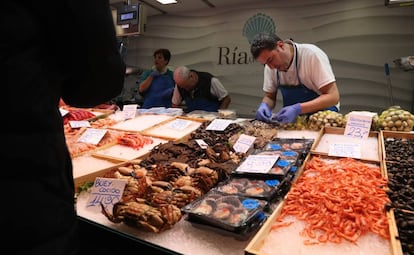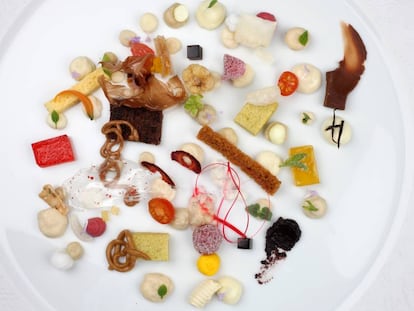French lamb and Turkish bass: The not-so-Spanish Christmas feast
Misleading labeling means that many people are not aware that many food products are being imported

As Spaniards prepare to sit down for their Christmas feast, they may be surprised to learn that much of their food has come from outside of Spain. The lamb being sold as Spanish may in fact be from Italy or France; the hake may come from the waters of northern Europe, Chile or Angola, and there is a 60% chance that the bass has not come from a fish farm in Guadalajara, in central Spain, but from Turkey, and a 20% chance it has come from Greece.
Spanish homes spent more than €68 billion on food last year
As for seafood, the supposedly wild-caught shrimp may have come from a fish farm in Colombia, Venezuela, Ecuador or even Iran. And while the white prawn was packaged in Huelva, in the southern region of Andalusia, it is more likely to have been shipped in from North Africa, and the red shrimp not from the Spanish Mediterranean but rather from Mauritania or Guinea.
The problem, according to the vice president of the Confederation of Consumers and Users (CECU), Ana Etchenique, is not whether the product is from Spain or imported, but rather misleading labeling. The Agriculture Ministry insists that food labels need to be transparent, but this job falls to the regional communities, which the sector has accused of ignoring the problem. There is no doubt about the origins of Scottish or Canadian lobster, the Argentinean big shrimp, French duck or Norwegian salmon.
In December, lamb imports jump to up to 3,500 tons, the equivalent of 600,000 animals
But there is more confusion with chicken that is often described as ¡°rural¡± and has a yellow color because it is fed with corn. These animals are raised in non-confined spaces but they are still not the same as?¡°campero¡± chickens, which are truly free-range and fed on a mixture of cereals.
According to food consumption figures, Spanish homes spent more than €68 billion on food last year, and an additional €34.5 billion on eating out, particularly in restaurants. The official figures show that the average monthly expenditure on food was between €5 and €5.5 billion, an amount that jumped 30% in December. This steep rise in food spending creates a gap between demand and supply, meaning that more products have to be imported if there are not enough domestic ones. What¡¯s more, some distribution companies choose to import cheaper, lower-quality products in a practice that can be borderline illegal.
Spain exports lamb throughout the year: it produces double what it consumes, but during these dates lamb imports ¨C particularly from France, Italy and Greece ¨C jump to 3,500 tons, the equivalent of 600,000 animals. The origin of the lamb must feature clearly on the label, if it is to be sold in parts, or on the receipt, if the entire animal is sold, which the butcher should communicate to customers. Colear, a lamb-selling cooperative from Aranda de Duero in the region of Castile and Le¨®n, notes that in the past it was common to see falsified labels selling French lamb as Spanish. Today this problem has been corrected, but there is still confusion over some labels. Many lambs from France are killed in slaughterhouses in the province of Burgos. The meat comes with a label clearly saying where the animal was slaughtered, but the origin of the animal is often not clear. The biggest difference is in the price: A kilogram of lamb from France can be three or four euros cheaper, given that the country earns more profit from milk and cheese, and less so from meat.
In the case of fish, the average monthly expenditure jumps from €700 million to €1.2 billion during the festive season, due mostly to the demand in salmon. Meanwhile, seafood consumption increases from between 20,000 to 22,000 tons to up to 52,000 tons in December. This leads to a sharp spike in the average monthly expenditure, which rises from €180 million to €500 million, buoyed in large part by the increased sale of octopus, shrimp and lobster.
English version by Melissa Kitson.
Tu suscripci¨®n se est¨¢ usando en otro dispositivo
?Quieres a?adir otro usuario a tu suscripci¨®n?
Si contin¨²as leyendo en este dispositivo, no se podr¨¢ leer en el otro.
FlechaTu suscripci¨®n se est¨¢ usando en otro dispositivo y solo puedes acceder a EL PA?S desde un dispositivo a la vez.
Si quieres compartir tu cuenta, cambia tu suscripci¨®n a la modalidad Premium, as¨ª podr¨¢s a?adir otro usuario. Cada uno acceder¨¢ con su propia cuenta de email, lo que os permitir¨¢ personalizar vuestra experiencia en EL PA?S.
?Tienes una suscripci¨®n de empresa? Accede aqu¨ª para contratar m¨¢s cuentas.
En el caso de no saber qui¨¦n est¨¢ usando tu cuenta, te recomendamos cambiar tu contrase?a aqu¨ª.
Si decides continuar compartiendo tu cuenta, este mensaje se mostrar¨¢ en tu dispositivo y en el de la otra persona que est¨¢ usando tu cuenta de forma indefinida, afectando a tu experiencia de lectura. Puedes consultar aqu¨ª los t¨¦rminos y condiciones de la suscripci¨®n digital.










































